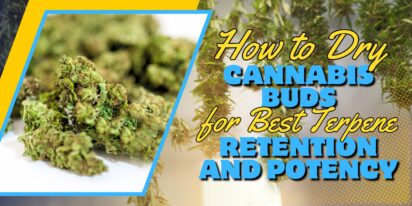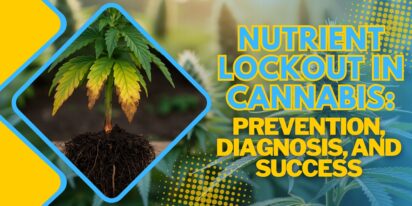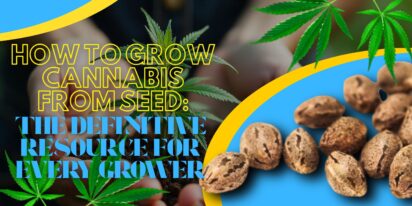Are You 21 Or Over?
YesOr
No By clicking yes, you certify that you are over 21 years old. By using this website, you agree to our legal disclaimer.Table of Contents

Just like other plants, autoflowering cannabis also requires its own growing requirements. In order for them to thrive and produce high yields, growers must be able to supply them with the nutrients that they need. In this article, you will be able to learn about different types of nutrients and the autoflower feeding schedule that you should provide for it.
Before you begin to plan your autoflower feeding schedule, you should learn to familiarize yourself with the different plant nutrients needed by your plants. This is normally categorized into two: macronutrients and micronutrients.
Macronutrients are given this name because they are commonly applied through using large quantities. This group is comprised of NPK or Nitrogen, Phosphorous, and Potassium. On the other hand, micronutrients are comprised of Manganese, Iron, Zinc, Copper, Sulfur, Calcium, and Magnesium. They are given to the plants in smaller amounts.
Both sets of nutrients are supplied to the plant in different ways, which can be via a slow-release powder, nutrients mixed with water, and through mixing with pre-amended soil. One of the most important things to remember is that there is a tendency to feed too little and too much to your plant, and that is the main reason why you should study the autoflower feeding schedule carefully.
The organic method of feeding cannabis plants comes with the theory that enriching the growing medium will also enrich the plant in a natural way. This would mean that you will not directly feed your plant. You will focus on taking care of your medium so that microorganisms will grow on the medium, break them down to smaller pieces so that the plant will be able to absorb them well.
This technique is used so that the plant will decide on its own how much it will absorb the nutrients that it needs. This will avoid having problems with going overboard with the nutrients because the plant decides on what it actually needs.
On the other hand, inorganic nutrients work through providing the nutrients by getting the exact amount of nutrients that it needs. Because everything will be addressed by your plant, the grower must be aware of the breakdown of the nutrients needed by the plants. As the exact numbers change from one to strain to another, you should first check and verify the needs of the strain that you choose to grow.
For autoflowering strains, it is essential that you know how to identify what are the nutrients that the plant requires because going overboard with organic nutrients will just waste all of them, and too much use of inorganic products will help you avoid burning all your plants. If you are unsure, you can always check on the manufacturers because they can provide that to you, and they must know everything about the plants that they sell.
At this moment, the seedlings only have a few leaves. They have two little ones that are called cotyledons, and they provide the plants the nutrition that they require at this young age until they mature and develop more leaves. Though the plant is still quite small, this first two weeks of the plant’s life is very crucial because the development is very fragile and mistakes at this point can harm the success of the yields at the end of the life cycle.
The nutrients that you should go with should only amount to 1/8 of the suggested amount. You should take caution in giving too much to your autoflower. There are many experts that even state that water alone will be enough to sustain the plant in its first two weeks. Overfeeding, in the worst case, will kill your plant.
Remember to read and research the exact nutrients that you should give as it depends on the strain and the growing medium that you will use.
Because you are growing an autoflowering cannabis plant, it will just breeze through the vegetative stage as it will quickly transition to flowering. You can observe this when the autoflowering plant is growing quite faster. At this point, you will be safe to give ½ of the recommended value of the nutrients. The emphasis on this part must be macronutrients, or Nitrogen, Phosphorous, and Potassium. In terms of weight, the Nitrogen must be larger compared to the other two. You may also decide to give them micronutrients – but only in smaller amounts.
When the flowering stage of your cannabis plant is reached, you should begin realigning the distribution of the nutrients for your plant. The amount of Nitrogen should be lessened, and more Potassium and Phosphorous should be introduced. Phosphorous will help your plant to produce more buds and fully bloom, so you should provide this to your plant to trigger the flowering stage.
Before the harvest season comes, you can get some slow-release nutrients through pellets that you can place in the growing medium. This will release the nutrients while you water your plant – or in simple terms, you will be able to flush them out.
| Week of Growth | Stage of Growth | Amount of Nutrients to Provide |
| 1 | Seedling | Water |
| 2 | Vegetative stage | 1/8 vegetative nutrient mix |
| 3 | Vegetative stage | ¼ vegetative nutrient mix |
| 4 | Pre-flowering stage | ½ vegetative nutrient mix |
| 5 | Little flowers growing | 1/8 vegetative nutrient mix &¼ blooming nutrient mix |
| 6 | Flowering stage | ½ blooming nutrient mix |
| 7 | Flowering stage | ½ blooming nutrient mix |
| 8 | Ripening stage | Flushing |
| 9 | Harvesting stage | Flushing |
If you are planning to grow autoflower seeds, you should study about their specific requirements and understand each part that is different from each other. You can use this autoflower feeding schedule guide, but it is still essential to keep on reading related articles and ask from experts until you are comfortable with the things that you know.

Curious about growing weed in a healthy, effective way? Welcome to the realm of weed hydro! This method uses water instead of soil, delivering n

Peyote Zkittlez is a unique cannabis strain that has quickly gained dedicated followers among enthusiasts and patients alike. Its parentage—Zk

As growers, we want strains that work well, are strong, and are of good quality. Autoflowering cannabis strains are a big step forward for both

Pot growers always ask the same basic question: How much weed does a weed plant produce? The answer is complex and depends on a multitude of var

Ever had the room spin after a few hits? You're not alone. Figuring out how to prevent getting dizzy high can make your cannabis experience a wh

Drying cannabis properly is a critical process in preserving the plant's full aroma and flavor and its psychoactive abilities. Tampering with th

Ever caught yourself a bit too high and all of a sudden in need of being normal? Whether you're heading out for munchies or bumping into someone

Looking for sage advice on how not to get pinched with weed without batting an eye? Attempting to protect your stash from gossipy roommates, sno

Nutrient lockout, also known as nutrient binding or chemical antagonism, is a significant issue in cannabis cultivation that negatively impacts

Germination is the most critical initial stage in growing healthy, high-quality cannabis plants. During germination, the dormant seed becomes a
Are You 21 Or Over?
YesOr
No By clicking yes, you certify that you are over 21 years old. By using this website, you agree to our legal disclaimer.
Excellent blog here Also your website loads up very fast What web host are you using Can I get your affiliate link to your host I wish my web site loaded up as quickly as yours lol
Your writing is not only informative but also incredibly inspiring. You have a knack for sparking curiosity and encouraging critical thinking. Thank you for being such a positive influence!
Simply wish to say your article is as amazing The clearness in your post is just nice and i could assume youre an expert on this subject Well with your permission let me to grab your feed to keep updated with forthcoming post Thanks a million and please carry on the gratifying work
Somebody essentially lend a hand to make significantly articles Id state That is the very first time I frequented your website page and up to now I surprised with the research you made to make this actual submit amazing Wonderful task
Your blog is a beacon of light in the often murky waters of online content. Your thoughtful analysis and insightful commentary never fail to leave a lasting impression. Keep up the amazing work!
Thank you for the auspicious writeup It in fact was a amusement account it Look advanced to more added agreeable from you By the way how could we communicate
Your blog is a constant source of inspiration for me. Your passion for your subject matter shines through in every post, and it’s clear that you genuinely care about making a positive impact on your readers.
Your blog is a constant source of inspiration for me. Your passion for your subject matter is palpable, and it’s clear that you pour your heart and soul into every post. Keep up the incredible work!
Your articles never fail to captivate me. Each one is a testament to your expertise and dedication to your craft. Thank you for sharing your wisdom with the world.
Your blog is a testament to your dedication to your craft. Your commitment to excellence is evident in every aspect of your writing. Thank you for being such a positive influence in the online community.
Your writing has a way of resonating with me on a deep level. I appreciate the honesty and authenticity you bring to every post. Thank you for sharing your journey with us.
Your blog is a true gem in the world of online content. I’m continually impressed by the depth of your research and the clarity of your writing. Thank you for sharing your wisdom with us.
Hi i think that i saw you visited my web site thus i came to Return the favore Im attempting to find things to enhance my siteI suppose its ok to use a few of your ideas
Somebody essentially help to make significantly articles Id state This is the first time I frequented your web page and up to now I surprised with the research you made to make this actual post incredible Fantastic job
Usually I do not read article on blogs however I would like to say that this writeup very compelled me to take a look at and do so Your writing taste has been amazed me Thanks quite nice post
Your blog has quickly become one of my favorites. Your writing is both insightful and thought-provoking, and I always come away from your posts feeling inspired. Keep up the phenomenal work!
Every time I visit your website, I’m greeted with thought-provoking content and impeccable writing. You truly have a gift for articulating complex ideas in a clear and engaging manner.
Hey there You have done a fantastic job I will certainly digg it and personally recommend to my friends Im confident theyll be benefited from this site
I have read some excellent stuff here Definitely value bookmarking for revisiting I wonder how much effort you put to make the sort of excellent informative website
Nice blog here Also your site loads up very fast What host are you using Can I get your affiliate link to your host I wish my site loaded up as quickly as yours lol
What i do not understood is in truth how you are not actually a lot more smartlyliked than you may be now You are very intelligent You realize therefore significantly in the case of this topic produced me individually imagine it from numerous numerous angles Its like men and women dont seem to be fascinated until it is one thing to do with Woman gaga Your own stuffs nice All the time care for it up
Your blog is a beacon of light in the often murky waters of online content. Your thoughtful analysis and insightful commentary never fail to leave a lasting impression. Keep up the amazing work!
Your blog is a breath of fresh air in the often stagnant world of online content. Your thoughtful analysis and insightful commentary never fail to leave a lasting impression. Thank you for sharing your wisdom with us.
Your blog is a beacon of light in the often murky waters of online content. Your thoughtful analysis and insightful commentary never fail to leave a lasting impression. Keep up the amazing work!
Usually I do not read article on blogs however I would like to say that this writeup very compelled me to take a look at and do it Your writing style has been amazed me Thank you very nice article
Your writing has a way of resonating with me on a deep level. I appreciate the honesty and authenticity you bring to every post. Thank you for sharing your journey with us.
This hydroponics guide is quite the buzz, seriously! Who knew growing weed without dirt could be so complicated yet potentially rewarding? The breakdown of systems like DWC and NFT is helpful, though I suspect my cat might confuse the air pump for a toy. The idea of cleaner buds is tempting, especially since explaining hydro weed to my non-growing friends might get messy. And the bit about potential dizziness from hydro weed? Perfect, now I have an excuse for why I always stumble a bit after a grow session. Still, the promise of faster grows and higher yields is hard to ignore, even if it means more trips to the pH meter than to the coffee shop. Overall, a cultivating read for the curious grower!